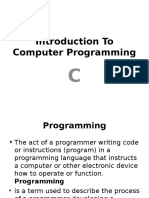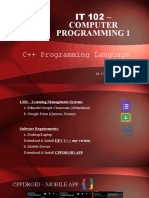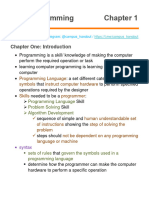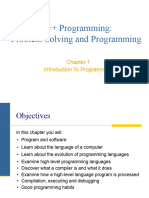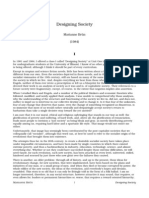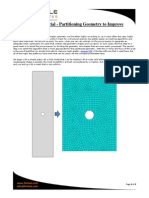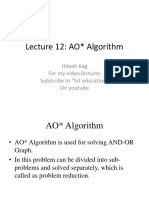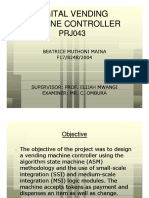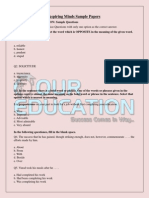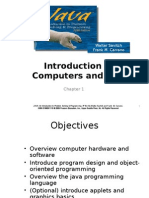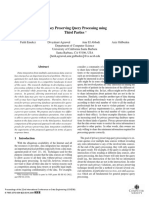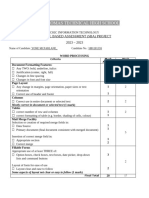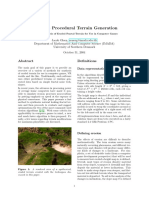ELEC 1032 – Computer Programming
Chapter 1
Introduction to Computer Programming
� Programming Languages
• Computer program: data and instructions used to
operate a computer and produce a specific result
– A program or set of programs is called software
• Programming: writing instructions in a language
that the computer can respond to and that other
programmers can understand
• Programming language: set of instructions that
can be used to construct a program
2
� Machine Language
• Executable program: program that can operate a
computer
• Executable programs are written with binary
numbers, which is a computer’s internal language
(machine language)
– An example of a simple machine language program
containing two instructions is:
11000000000000000001000000000010
11110000000000000010000000000011
• Opcode is short for operation code; tells the
computer the operation to be performed
3
� Assembly Language
• Assembly language: uses the substitution of word-
like symbols for the opcodes, and decimal numbers
and labels for memory addresses
LOAD first
ADD second
MUL factor
STORE answer
4
�Assembly Language (continued)
5
� Low- and High-Level Languages
• Machine and assembly languages are low-level
languages because they both use instructions that
are directly tied to one type of computer
• Programs written in a computer language are
referred to as source programs and source code
• When each statement in a high-level source
program is translated individually and executed
immediately upon translation, the programming
language is called an interpreted language
• Interpreter: program that translates each
statement in a high-level source program and
executes it immediately upon translation
6
� Low- and High-Level Languages
(continued)
• Compiled language: the statements in a high-level
source program are translated as a complete unit
before any individual statement is executed
• Compiler: translates a high-level source program
as a complete unit before any statement is executed
– The output produced by the compiler is called an
object program (machine language version of the
source code)
• Linker: combines additional machine language
code with the object program to create a final
executable program
7
�Low- and High-Level Languages
(continued)
8
� Procedural and Object-Oriented
Languages
• Procedural language: instructions are used to
create self-contained units, called procedures
– Procedure: accepts data as input and transforms it in
some manner to produce a specific result as output
• Also called function or method
• Procedures conforming to structure guidelines are
known as structured procedures
9
� Procedural and Object-Oriented
Languages (continued)
• Structured language: high-level procedural
language (e.g., C) that enforces structured
procedures
• Object-oriented languages: languages with
object orientation such as C++, Java, Visual Basic,
and C#
10
�Procedural and Object-Oriented
Languages (continued)
11
� The Development of C
• Developed in the 1970s at AT&T Bell Laboratories
by K. Thompson, D. Ritchie, and B. Kernighan
• High-level structured language
– Can also access the internal hardware of a computer
• C permits a programmer to “see into” a computer’s
memory and directly alter data stored in it
• Standard maintained by the American National
Standards Institute (ANSI)
• In the 1980s, Bjarne Stroustrup (working at AT&T)
developed C++
– C with object-oriented capabilities
12
� Algorithms
• Algorithm: specific steps required to produce a
desired result
Set n equal to 100
Set a equal to 1
Set b equal to 100
Calculate sum = n(a+ b)/2
Display the sum
• When English phrases are used to describe an
algorithm, the description is called pseudocode
Input the three numbers into the computer
Calculate the average by adding the numbers and dividing the
sum by three
Display the average
13
�Algorithms (continued)
14
� Algorithms (continued)
• When mathematical equations are used to describe
an algorithm, the description is called a formula
• Flowchart: provides a pictorial representation of
an algorithm using specifically defined shapes
15
�Algorithms (continued)
16
�Algorithms (continued)
17
� Algorithms (continued)
• Converting an algorithm into a computer program,
using a language such as C, is called coding the
algorithm
• The program instructions resulting from coding an
algorithm are called program code, or simply
code
18
�Algorithms (continued)
19
�Case Study: Design and Development
• The circumference, C, of a circle is given by the
formula C = 2r, where is the constant 3.1416,
and r is the radius of the circle. Using this
information, write a C program to calculate the
circumference of a circle that has a 2-inch radius.
• Step 1: Analyze the problem
– Determine the desired outputs
– Determine the input items
– List the formulas relating the inputs to the outputs
– Perform a hand calculation
20
�Case Study: Design and Development
(continued)
• Step 2: Select an overall solution algorithm
– Set the radius value to 2
– Calculate the circumference, C, using the formula C = 2 r
– Display the calculated value for C
• Step 3: Write the program (see next slide)
• Step 4: Test and correct the program
– The circumference of the circle is 12.566400
– Because only one calculation is performed by the
program, testing Program 1.1 really means verifying
that the single output is correct
21
�Case Study: Design and Development
(continued)
22
� Common Programming Errors
• Rushing to write and execute a program without
spending sufficient time learning about the problem
or designing an appropriate algorithm
• Forgetting to back up a program
• Not understanding that computers respond only to
explicitly defined algorithms
23
















